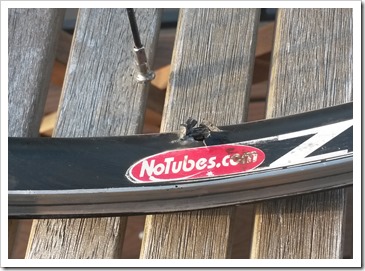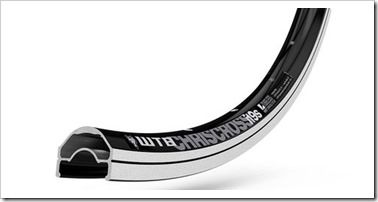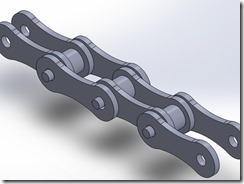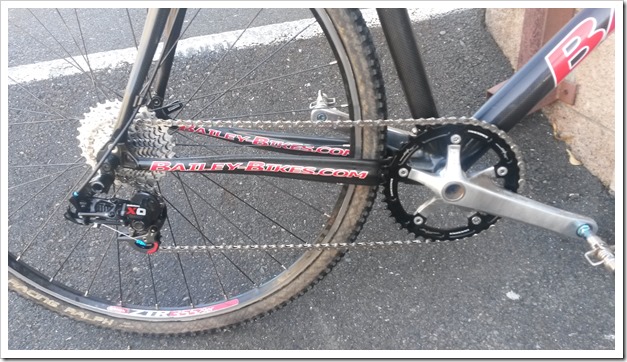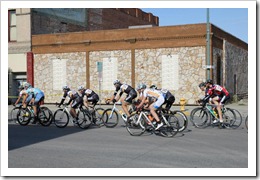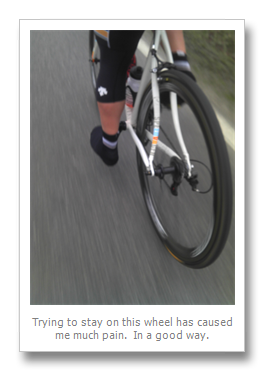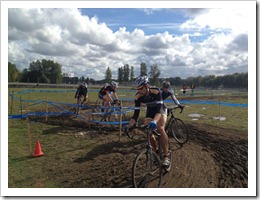Chain Waxing
You’ve probably known about this for a long time, but figured it was not worth the hassle. And yeah, it used to be, but there are some things you can do to make it a lot easier. Could it actually SAVE you time? Sure it can.
What is it?
If you’re reading this, you probably already know. However, the idea is you submerge your bike chain in molten wax containing lubricating additives. The wax penetrates into your chain, into the rollers where it’s needed. When the wax cools, it will adhere to your chain and stay inside the rollers.
It’s Clean
A waxed chain is a clean chain. After a long ride, I can run my finger along the chain, and it's clean. Not only is that nice, but it comes with benefits:
- Drivetrain stays clean, no more greasy buildup
- Less grime and grit means less wear on your components. Your chain, cassette and chainrings will last longer.
- Your bike looks better for less work
Your drivetrain will stay clean, which means less maintenance for you. Normal lube is faster and more convenient, but you’ll make a mess and have to clean your bike a lot more frequently. So, you actually reduce net maintenance time with chain wax.
Develop Your Wax Strategy
There are a few things you can do to make waxing a chain almost as convenient as using normal bike lube. Think of it as your waxing strategy.
My First Strategy
Initially, I put about six chains in rotation. They hang on two nails on the wall:
- one for waxed chains ready to go
- one for chains I pulled off the bike needing to be rewaxed
When it was time to lube the chain, I just popped it off, hung it on the “dirty” nail, and switched to a chain with fresh wax. When the waxed-and-ready nail is empty, I just rewax all the used chains at once.
Adding Liquid Wax to the Mix
Liquid chain wax can make your life easier. It’s just chain wax that’s been dissolved in some sort of carrier liquid. You lube your chain with it, the liquid gets the wax in the rollers (where it needs to be), and then the liquid evaporates. That liquid could be something like alcohol, paint thinner, or even just water.
My current wax strategy is to wax the chain as before, and then hit it with a liquid wax lube in between rewaxing. It’s not quite as good as hot wax, but it is still pretty good. It's perfect for maintaining your chain between waxing, and it’s really easy. The only thing you should keep in mind is try to lube the chain after your ride, or the night before you ride, so it has time to dry properly. You can buy liquid wax from brands such as Silca. You can also make your own.
Choosing Your Wax
Home Brew Wax
You can certainly make your own. The easiest home brew formula is to combine about a pound of paraffin wax with about 40 grams or so of PTFE (Teflon) powder. The Friction Facts UltraFast formula is 1 pound paraffin, 5g of PTFE powder, and 1g of Molybdenum disulfide (MoS2). I’ve used both and haven’t seen a huge difference, but I think the PTFE/MoS2 combo works a little better. I like just the PTFE formula because it’s white and cleaner. Adding the moly stuff makes it black, like oil, and it is just a little messier if you spill it or get it on your clothes. It’s not a deal breaker, though.
While food grade paraffin is easy to come by at many grocery stores, the Teflon (PTFE) and MoS2 might not be so easy. You need to use the ultra small particle stuff, less than 2 microns. You can use larger particle powder, like piano lube powder, but it’s apparently more prone to clumping. Both can be found on Amazon, but they aren’t as inexpensive as you can get elsewhere from more questionable sources. Either way, it costs less to go that route than buy ready made wax.
Ready Made Wax
I got in my own head about this. I originally had trouble finding a source of the PTFE powder, so I got it from Ali Express. It worked fine but I wondered how pure was it? How would i know if it wasn’t? Could my chain wax work better if I had a better source?
When it was time to buy more wax, I ended up getting something ready made from a small company named Runaway Bike. I figured they must put more energy into ensuring the quality of the ingredients than I can, and the cost isn’t much different. A pound of chain wax can last you a long time. A year or two is totally doable if you clean your chains before rewaxing them (more on that below), especially if you use the web lube strategy mentioned above.
Runaway’s product is pretty good, and it uses the tried and true formula from Friction Facts. However, some of those ingredients might not be so good for your health. After I read this, my feelings about handling ultra fine partials of Teflon changed a bit.
Silca also makes a great wax, and it’s a different formula. No PTFE or MoS2. It’s supposed to be more eco friendly and less harmful to your body. It’s also supposed to be faster, so hey, there’s a reason for everybody to give it a try. It’s a little more expensive than Runaway, but again, this will last a long time so it’s not really significant.
Preparing Your Chain – the Hard Part
Chain wax simply will not work if you don’t prep the chain before hand. It’s the hardest part of waxing a chain. Basically, your chain needs to be completely degreased before you can wax it. Keep in mind this is something you only need to do once. Subsequent cleanings are just done with hot water and super easy.
This can be a huge pain, involving bathing and agitating the chain in multiple solvents and chemical treatments. Friction Facts has some good instructions but you can find good instructions all over the internet. This process is not super fun, so I would recommend you prep several chains at once. I have done this numerous times, and it works well, but you really need to make sure you chain is completely grease free. It should not feel greasy, and rattle when you shake it; that’s a good way to tell it’s ready to wax.
Game Changer
Silca came up with an easy one step chain stripper that works in like 20 minutes. One step, 20 minutes, done. And the film it leaves behind on the chain is even supposed to help adhesion of the wax to your chain. I don’t know about that part, but this stuff blew my mind and it definitely works. Game changer. I don’t know what’s in it, but it works.
Don’t Forget the Drivetrain
Don’t forget to degrease your cassette and chainrings. You don’t want grease compromising the chain. It’s really nice to start with a new cassette if you can.
Chain Choice
I’ve tried a variety of chains. Some chains are great for waxing, and some aren’t. I know it might sound questionable, but I believe the coating/treatment of a chain is a big factor for how well the wax will adhere to it. YBN chains with SLA treatment are supposed to be the best. I’ve been using them for years, and they are indeed excellent. I’ve had success with cheaper chains, too, like the SRAM 1110/1130. I think a higher up model from SRAM would probably work a little better, but the cheaper ones are fine too. Shimano works fine. Wipperman is supposed to be great, but I haven’t purchased one yet. The only chain I regret buying is KMC. I bought several of them at once and the wax seems to wear off after maybe an hour of riding. Stay clear of KMC for waxing unless they change something. You can buy chains from your local bike shop or favorite retailer and degrease them as described above. You can also buy pre-waxed chains from several companies. You can even find them on Etsy. They are more expensive, obviously, but you won’t have to degrease them.
Equipment
Melting Pot
You’ll need a crock pot or instant pot. Get as small size as you can find. 2 quarts is perfect. The bigger it is, the more shallow the wax will be. You might need twice as much wax if you use a giant crock pot. I started with a small 2 quart crock pot, which was $10 at Target. It has worked great, but like all crock pots, they take a while to heat up and melt the wax. Instant Pots are way faster, and you can control the heat a little better, but they are more expensive. It’s just a matter of speed, really. They both work equally well. I hope it goes without saying you need a dedicated crock pot. Have a look at mine, which has been waxing for about 5 years now:
You’re not going to want to make soup in that. You could buy a replacement liner pan for it and just use a dedicated pan for wax. It’s viable, especially if you get an instant pot since they cost a lot more. Regardless, once you put wax in this thing, it will never be the same again.
Old spoke or old wire coat hanger
Finally you have a use for that broken spoke you’ve been saving in your garage for 12 years! Just bend it into a square hook to wrap the chain on.
Gloves, Protection
You will be working with molten hot wax, which makes your chain really hot to the touch. It is rather unpleasant to handle it immediately after waxing, so you might want to use some gloves. If you have “chef hands” and can handle hot stuff, you can go without if you are careful. It’s kind of like making crepes...actually no it’s worse than that. Your gloves should obviously be clean. You might also want some eye protection, too.
Reusable Chain Quick LInks and Chain link Pliers
Waxing chains means you’ll be removing them a LOT. Always use quick links, and have extras handy. Get yourself some plyers for removing the quick link AND replacing it. Two separate tools (one for removing, one for installing) work better than one that does both jobs. You don’t really need a tool for reconnecting the chain, but it makes life so much nicer. I would advise you always use a tool to remove the quick link, since it’s easier and more gentle than any other method I can think of.
Waxing your Chain
Finally, time to get down to business. It’s a fairly simple procedure. But first, prepare your chains. If they are new and you just degreased them, you are good to go. If you are re-waxing, you should clean it with a simple procedure:
- turn on the crock pot, get the max melting while you prepare your chain(s). It takes a while to melt.
- boil some water
- pour hot water over your chain and shake the chain a bit to flush out the dirt and let the old wax melt and get out of the rollers.
- wipe chain down while still hot. You might want to grab those gloves.
- let the chain dry for a bit. Bonus points if you swing it around over your head like a ninja.
Once your chains are clean, and the wax is liquid, it’s time to wax. The idea is to allow the hot wax to penetrate into the chain. When the wax cools, it will remain in the chain rollers, where it’s needed. The paraffin alone acts as a lubricant, but the additives make it more effective.
- String the chain on your makeshift chain hook
- submerge it into the wax
- Stir it around for 30 seconds or so
- let it sit 10-20 minutes, maybe swish it around in that time if you remember
- swish it one last time, remove from wax. Be careful, it’s hot, and it can be messy.
- remove the chain from the hook and let it dry. I have a shallow cardboard box I use. Just plop the chain in the box in a heap and let it dry
- You can wax your quick links, too. Just put them on your chain hook along with the chain.
That’s it! You can now repeat as necessary with as many chains as you want.
Bonus Step #1
If you want to get fancy, there is an optional step. Before you remove the chain, turn off the crock pot. You can remove the liner pan and set it on a workbench so it will cool faster. Keep an eye on the wax, and when it starts to get dull in color, a film will start to form on the surface. At that point, remove your chain. The idea is the chain will be less viscous and the wax you worked so hard to get inside the rollers will be less likely to leak out. It’s a cool idea but I never do it.
Bonus Step #2
After the wax dries and cools completely (at least a few hours, 6 or 12 better), put the chain on a bike, and pedal for a minute or so. This will allow the excess wax to flake off, as it always does. Then, treat the chain with liquid wax. The idea is this will fill any voids that formed after the wax cools. It’s another cool idea and I actually do this one when I’m not being lazy.
Post Wax Installation
When the wax dries, your chain will be pretty stiff. You can wrap the chain around something round, hold both ends, and pull it back and forth to break some of the wax free. However, I usually skip that and simply install the chain on the bike, and it will flake off on its own in the first 30 pedal strokes of my ride. Your chain might skip or not shift well for those 30 pedal strokes, but it will be fine after that.
The two open holes at each end of the chain will often fill with wax, and the surface of those two chain ends can sometimes get a thick layer of wax adhered to it. Before you install the chain, push the quick link through each hole to remove the wax. You can also scrape the two end links with that quick link to remove any thick wax residue, which can make it challenging to engage the quick link.
If you have a pair of chain plyers that reconnect the chain link, great. If not, connect the quick link the top (highest) part of your chain. To fully close the quick link, just hold the bike still and pedal with your hand. That’s plenty of leverage to close the link.
Time to re-wax
You will know it’s time to re-wax your chain when it starts to make a lot of noise. I go 3-5 rides between treating the chain. I’d say you can do 200-300 miles but probably not more than that, and less if you’re riding in the rain. I treat my chain often with liquid wax the night before a ride, which allows me to delay re-waxing until at least 12 rides. Alternatively I just swap a freshly waxed chain I have ready in waiting if I am heading out for a big ride and realize I forgot to treat the chain with liquid wax the night before. It really doesn’t take any more time than lubing your chain the traditional way.
Drawback – The lack of spontaneity
There are pros and cons to everything. For waxing chains, the biggest con I can think of is you have to think ahead. If you are about to head out for a ride and realize you forgot to wax your chain after that big ride in the rain over the weekend, that could be a bummer. That’s why I try to keep extra pre-waxed chains ready, just in case. You can use liquid wax in a pinch, but it won’t work as well as if you let it dry before riding.
During a gravel race, especially a wet or dirty one, any chain can get compromised. I’ve used a little bottle of Squirt lube (it’s wax based) with success before. Or you can put some liquid wax you have in a tiny bottle (like a bottle for eye drops) and carry that in your pack just in case.
In a real pinch, if it means your ride will be compromised, just use any lube you can find. It’s no big deal, you’ll just have to degrease your chain and drivetrain before going back to wax.
Time for More Wax
Every time you wax your chain, some of the wax in your pot comes out with the chain. Over time, you’ll use it up. When it’s difficult to submerge your chain, it’s time to get some more. I would not keep the old wax and combine it with new wax, because every time you wax your chain you’ll put a little more dirt in it. It’s best not to keep that around.
You can just plop out the entire puck of wax when you want to change it. If you can’t get it out, turn on the crock pot for a bit until the edges start to melt, then it should come out. If you’ve lost any quick links while waxing, turn the puck over and you’ll probably see them embedded in the wax.
Bonus Tips
- Different bikes often have different sized chains. I use different color chains for different bikes. For example, the race bike could use a gold chain, another could use a silver chain. There’s also black and rainbow (oil slick) colored chains.
- Use reusable links. KMC makes some good ones. While their chains are not good for waxing (in my experience) their links are great. Wipperman are good, too. Single use links (e.g. SRAM and Shimano) can probably be reused numerous times, too, but they say they are single use. My rule of thumb is when the quick link stops clunking into place when you refasten it, it’s time to replace it.
- Use a quick link that’s a different color than your chain. For example, if you have a gold chain, use a silver or black link. It’s so much easier to find when it’s time to remove it.
- I already said this above, but it is really handy to have multiple chains waxed and ready to go so you can change them on a whim, or bring an extra with you on a stage race.
Safety Considerations
- First and foremost, don’t burn yourself. Be careful, wear gloves until you know what to expect, and consider protecting your eyes, too. If you were to somehow spill a pot of molten wax on yourself…ish please just don’t let that happen. Don’t place the power cord of your crock pot such that you, your kids or your pets can trip over it and knock it over. This has never happened to me, and I’ve never heard of it happening. It should go without saying we need to be careful when handling this stuff but this is the internet so there you go.
- Work in a ventilated environment. PTFE fumes can’t be good for you and your family.
- Paraffin is okay to handle. It’s often sold as a food grade product. The other stuff is not. I would wear gloves if you’re handling the nano particle lubrication agents, and wash your hands when you’re done. I don’t know for a fact it’s harmful but at the very least, gloves can’t hurt.
- Paraffin fumes could potentially ignite. Avoid open flames!




